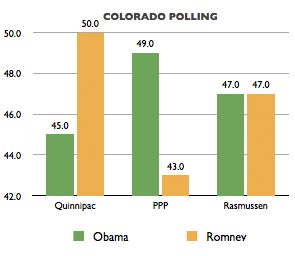Based upon the media coverage of the first presidential debate, it’s not surprising to witness at least a short-term tightening of the national campaign. Fortunately for Republican nominee Mitt Romney, his standing is also improving in the most important swing states.
In Florida, two polling firms now are projecting Romney to be leading President Obama. The Sunshine State is the Republican’s most important conversion entity because there is simply no way to compensate for losing its 29 Electoral Votes. According to Rasmussen Reports (RR) on the day after the presidential debate (Oct. 4; 500 likely Florida voters), the GOP challenger has taken a two-point, 49-47 percent lead. We Ask America (WAA), which ran approximately 1,200 sample automated polls in the three most important swing states also on Oct. 4, finds Romney now leading in Florida, as well. Their margin is 49-46 percent.
Similar results are found in Virginia, another of the critical four core states. Romney’s easiest path to victory is to convert each of the cores (Florida, North Carolina, Virginia and Ohio), and then take at least one more Obama state that is larger than Vermont or Delaware. The President wins re-election, for all intents and purposes, if he takes Florida or any two of the core states.
Rasmussen Reports, testing 500 Old Dominion state likely voters on Oct. 4, found a 49-48 percent Romney lead in Virginia. We Ask America, also on the same date, detected a 48-45 percent GOP challenger advantage.
In Ohio, RR still forecasts the President to be leading, but by just one point, 50-49 percent. WAA, however, sees Romney forging ahead in this critical state, up by the same one-point spread, 47-46 percent.
Regardless of whether these small margins are completely accurate, they do tell us that Romney did receive, at the very least, a quick momentum surge that penetrated into the states that will have the largest say in determining the final outcome of this presidential election.
It remains to be seen if the Romney debate bump sustains itself for more than a few days. The electorate, throughout the 2012 election cycle, seems all too willing to shift on a dime and the challenger’s improved standing could be yet one more example of this phenomenon. If so, then the vast majority of polling between now and the last week of October won’t tell us too much because we know things can quickly change based upon external events. If Romney’s improved standing holds through the next week, though, then a new, firmer Republican base may well be formulating.
What we can confidently determine is that 39 states and the District of Columbia have made their decision about this presidential contest. Among the decided states, the President enjoys a 201-176 advantage. This means Pres. Obama needs to convert 69 of the remaining 161 Electoral Votes, or 43 percent of them. Romney, on the other hand, needs 57 percent — or 94 of the remainder.
-
The 11 undecided states are, from west to east:
- Nevada (tilting Obama, but approaching toss-up status)
- Colorado (tilting Obama, but approaching toss-up status)
- Iowa (pure toss-up)
- Wisconsin (tilting Obama, but approaching toss-up status)
- Michigan (leaning Obama)
- Ohio (leaning Obama)
- Pennsylvania (leaning Obama)
- New Hampshire (leaning Obama)
- Virginia (tilting Obama, but approaching toss-up status)
- North Carolina (leaning Romney)
- Florida (tilting Romney, but again approaching toss-up status)
Understanding where the states currently stand, and even giving Iowa to Romney, the president would win re-election with 297 Electoral Votes. But, make no mistake, his political position is precarious. For an incumbent to be this close to losing a month away from Election Day is a bad sign for him because the majority of voters are not yet positively convinced after four years of performance from which to judge. This race remains undecided.




